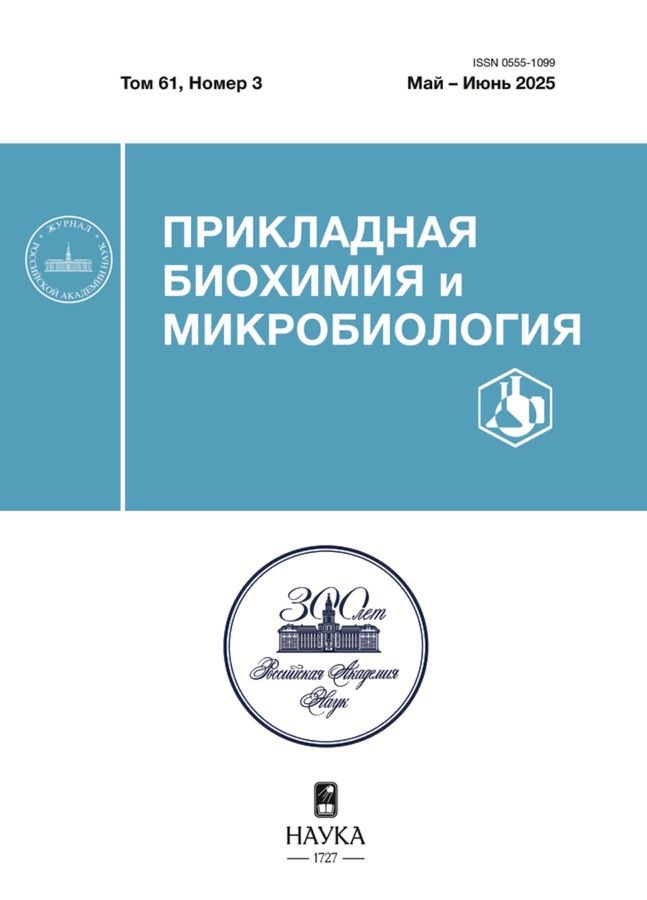Применение технологии Detectr для селективной детекции бактериального фитопатогена Dickeya solani с использованием рекомбинантной CRISPR-нуклеазы Cas12a, полученной одностадийной хроматографической очисткой
- Авторы: Курбатов Л.К.1, Радько С.П.1,2, Хмелева С.А.1, Птицын К.Г.1, Тимошенко О.С.1, Лисица А.В.1,2
-
Учреждения:
- Научно-исследовательский институт биомедицинской химии им. В. Н. Ореховича
- Тюменский государственный университет, Западносибирский межрегиональный научно-образовательный центр
- Выпуск: Том 60, № 1 (2024)
- Страницы: 20-28
- Раздел: Статьи
- URL: https://cardiosomatics.ru/0555-1099/article/view/674571
- DOI: https://doi.org/10.31857/S0555109924010025
- EDN: https://elibrary.ru/HDBPCB
- ID: 674571
Цитировать
Полный текст
Аннотация
В работе показано, что рекомбинантная CRISPR-нуклеаза Cas12a, полученная упрощенным методом очистки после ее гетерологической экспрессии с применением одностадийной металл-хелатной хроматографии, может быть успешно использована в технологии DETECTR. Полученная таким способом CRISPR-нуклеаза Cas12a в комбинации с рекомбиназной полимеразной амплификацией позволила обеспечить селективность детекции Dickeya solani — опасного фитопатогена, вызывающего заболевание картофеля, известное как “черная ножка”, с пределом обнаружения 1 копия бактериального генома на реакцию амплификации. Результат может быть определен визуально, без использования сложных инструментальных методов, по изменению окраски реакционной пробы при освещении синим светом, что создало основу для разработки полевой ДНК-диагностики D. solani. Применение упрощенной хроматографической очистки позволит существенно снизить затраты времени и ресурсов, необходимые для получения функционально активной CRISPR-нуклеазы Cas12a, при разработке и производстве ДНК-диагностикумов на основе технологии DETECTR.
Ключевые слова
Полный текст
Об авторах
Л. К. Курбатов
Научно-исследовательский институт биомедицинской химии им. В. Н. Ореховича
Автор, ответственный за переписку.
Email: kurbatovl@mail.ru
Россия, Москва, 119121
С. П. Радько
Научно-исследовательский институт биомедицинской химии им. В. Н. Ореховича; Тюменский государственный университет, Западносибирский межрегиональный научно-образовательный центр
Email: radkos@yandex.ru
Россия, Москва, 119121; Тюмень, 625003
С. А. Хмелева
Научно-исследовательский институт биомедицинской химии им. В. Н. Ореховича
Email: kurbatovl@mail.ru
Россия, Москва, 119121
К. Г. Птицын
Научно-исследовательский институт биомедицинской химии им. В. Н. Ореховича
Email: kurbatovl@mail.ru
Россия, Москва, 119121
О. С. Тимошенко
Научно-исследовательский институт биомедицинской химии им. В. Н. Ореховича
Email: kurbatovl@mail.ru
Россия, Москва, 119121
А. В. Лисица
Научно-исследовательский институт биомедицинской химии им. В. Н. Ореховича; Тюменский государственный университет, Западносибирский межрегиональный научно-образовательный центр
Email: kurbatovl@mail.ru
Россия, Москва, 119121; Тюмень, 625003
Список литературы
- Kaminski M. M., Abudayyeh O. O., Gootenberg J. S., Zhang F., Collins J. J. // Nat. Biomed. Eng. 2021. V. 5. № 7. P. 643–656.
- Fapohunda F. O., Qiao S., Pan Y., Wang H., Liu Y., Chen Q., Lü P. // Microbiol. Res. 2022. V. 259. P. 127000. https://doi.org/10.1016/j.micres.2022.127000
- Gootenberg J. S., Abudayyeh O. O., Lee J. W., Essletzbichler P., Dy A. J., Joung J. et al. // Science. 2017. V. 356. № 6336. P. 438–442.
- Chen J. S., Ma E., Harrington L. B., Da Costa M., Tian X., Palefsky J. M., Doudna J. A. // Science. 2018. V. 360. № 6387. P. 436–439.
- Yuan B., Yuan C., Li L., Long M., Chen Z. // Molecules. 2022. V. 27. № 20. P. 6999. https://doi.org/10.3390/molecules27206970
- Lobato I. M., O’Sullivan C.K. // Trends Analyt. Chem. 2018. V. 98. P. 19–35.
- Zetsche B., Gootenberg J. S., Abudayyeh O. O., Slaymaker I. M., Makarova K. S., Essletzbichler P. et al. // Cell. 2015. V. 163. № 3. P. 759–771.
- Chen J., Huang Y., Xiao B., Deng H., Gong K., Li K., Li L., Hao W. // Front Microbiol. 2022. V. 13. P. 842415. https://doi.org/10.3389/fmicb.2022.842415
- Курбатов Л. К., Радько С. П., Кравченко С. В., Киселёва О. И., Дурманов Н. Д., Лисица А. В. // Прикл. биохимия и микробиология. 2020. Т. 56. № 6. P. 587–594.
- van der Wolf J. M., Nijhuis E. H., Kowalewska M. J., Saddler G. S., Parkinson N., Elphinstone J. G. et al. // Int. J. Syst. Evol. Microbiol. 2014. V. 64. № 3. P. 768–774.
- Toth I. K., van der Wolf J. M., Saddler G., Lojkowska E., Helias V., Pirhonen M. et al. // Plant Pathol. 2011. V. 60. № 3. P. 385–399.
- Pritchard L., Humphris S., Saddler G. S., Parkinson N. M., Bertrand V., Elphinstone J. G., Toth I. K. // Plant Pathol. 2013. V. 62. № 3. P. 587–596.
- Humphris S. N., Cahill G., Elphinstone J. G., Kelly R., Parkinson N. M., Pritchard L., Toth I. K., Saddler G. S.// Methods Mol. Biol. 2015. V. 1302. P. 1–16.
- Van Vaerenbergh J., Baeyen S., De Vos P., Maes M. // PloS One. 2012. V. 7. № 5. P. e35738. https://doi.org/10.1371/journal.pone.0035738
- Ivanov A. V., Safenkova I. V., Drenova N. V., Zherdev A. V., Dzantiev B. B. // Mol. Cell. Probes. 2020. V. 53. P. 101622. https://doi.org/10.1016/j.mcp.2020.101622
- Suprun E. V., Khmeleva S. A., Kutdusova G. R., Ptitsyn K. G., Kuznetsova V. E., Lapa S. A. et al. // Electrochem. Commun. 2021. V. 131. P. 107120. https://doi.org/10.1016/j.elecom.2021.107120
- Murugan K., Seetharam A. S., Severin A. J., Sashital D. G. // J. Biol. Chem. 2020. V. 295. P. 5538–5553.
- Mohanraju P., Oost J., Jinek M. Swarts D. // Bio-protocol. 2018. V. 8. P. e2842. https://doi.org/10.21769/BioProtoc.2842
- Moreno-Mateos M. A., Fernandez J. P., Rouet R., Vejnar C. E., Lane M. A., Mis E. et al. // Nat. Commun. 2017. V. 8. № 1. P. 2024. https://doi.org/10.1038/s41467-017-01836-2
- Tran M. H., Park H., Nobles C. L., Karunadharma P., Pan L., Zhong G., Wang H. et al. // Mol. Ther. Nucleic Acids. 2021. V. 24. P. 40–53.
- Owens R.M, Grant A., Davies N., O’Connor C.D. // Protein Expr. Purif. 2001. V. 21. № 2. P. 352–360.
- Kurbatov L. K., Radko S. P., Khmeleva S. A., Timoshenko O. S., Lisitsa A. V. // Biomed. Chem. Res. Meth. 2022. V. 5. № 4. P. e00177. https://doi.org/10.18097/BMCRM00177
- Khayi S., Blin P., Chong T. M., Robic K., Chan K. G., Faure D. // Genome Announc. 2018. V. 6. № 4. P. e01447–17. https://doi.org/10.1128/genomeA.01447-17
Дополнительные файлы















